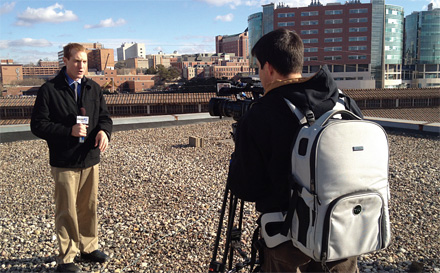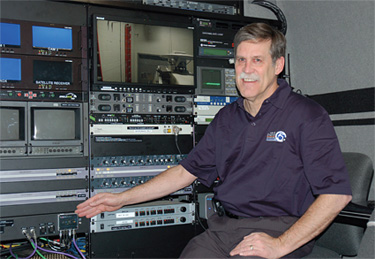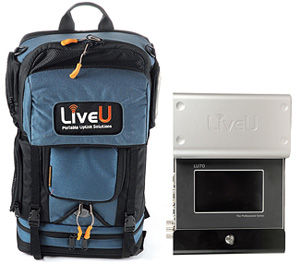HD ENG Unleashed
HAMILTON, N.J.—When it comes to electronic newsgathering (ENG) in HD, there's been an SD "no-mans-land" between the HD studio and HD cameras in the field. Since upgrading the ENG microwave infrastructure to HD is very costly, many broadcasters have resigned themselves to shooting HD but backhauling content in SD.
But next-generation solutions could circumvent the microwave bottleneck cost-effectively by harnessing advanced MPEG-4 AVC and L4/L3 compression, faster CPUs in cellphones, and IP transmission over multipath 3G/4G LTE cellular networks, Wi-Fi, or the Internet.
"The amount of money you have to invest to transmit HD video via microwave is not insignificant," said Rich Adams, chief operating officer for Hoak Media Corp., a station group in Dallas. "We've managed to leapfrog this investment with a breakthrough approach."
LEVEL PLAYING FIELD

In January, Hoak Media deployed a new solution called TVUPack across its 23 TV stations to enable news crews to cost-efficiently transmit live HD video. TVUPack is powered by TVU Network's proprietary Inverse StatMux technology that dynamically segments a live video signal and transmits the segments through multiple independent 3G/4G/Wi-Fi/WiMax connections, resulting in a low- latency, real-time, HD feed.
Adams notes that the TVUPack allows the group's smaller market stations—including KNOP-TV, the NBC affiliate in North Platte, Neb., which is 209th out of 211 markets—the ability to compete against its bigger cousins. "This capability puts this small market station on the same footing with large market stations. It levels the playing field for stations that don't have the capital the big boys do," he said.
Since the TVUPack fits in a backpack, a one-man video crew can drive around to do the traffic report, or walk around the local diner interviewing people, all while sending live HD pictures back to the station using low-cost cellular networks.
"You don't have to park the ENG/SNG truck, get the generators going, orient the dish, acquire the satellite, or any other preparations," Adams said. "With the push of a button, the cameraman has unprecedented freedom to send live HD video signals from anywhere you can connect to wireless."
ENG-OVER-IP
The market for ENG-over-IP is rapidly expanding with a number of companies entering the market.
LiveU, which has seen its LiveU portable video over cellular solution used at such venues as the Super Bowl and the Grammys, recently announced an agreement with Sprint in which the telecom will incorporate LiveU's backpack video transmission technology into Sprint's "Machine-to-Machine" initiative (M2M refers to technologies that allow both wireless and wired systems to communicate with other devices of the same ability). Sprint said it intends to use the LiveU technology to create "a mobile video transmission solution that delivers HD video quality and combines multiple 3G and 4G air cards for one resilient uplink."

Berry Pinney, director of engineering and operations at WEWS-TV in Cleveland LiveU recently announced its LU70 cellular ENG uplink solution, featuring a second generation internal and external antenna array, One-Touch-Live mode with automotive adjustment of video resolutions, point to multipoint distribution, increased throughput over 10 Mbps for improved video quality, and an instant Wi-Fi access point, providing wireless connectivity over Wi-Fi, for areas with limited network connections. The Hackensack, N.J.-based company counts Cox and Sinclair among its broadcast customers.
Other options include Comrex in Devens, Mass., which until recently primarily developed professional audio products. The company dove into the IP-ENG market last year with its LiveShot system, which uses H.264 encoding and is optimized for challenging IP networks like 3G, 4G and satellite-based links.
Dejero in Waterloo, Ontario, offers up its LIVE+ SD/HD system, which consists of four elements: a portable handheld transmitter that directly connects to a camera; cloud manager for monitoring Dejero assets and managing video sources and their destinations with an intelligent online interface; management device for tying the transmitter into a video server; and a receiving unit that decodes the transmissions for ingest.
Somerset, N.J.-based DSI RF Systems' NewsShark is a portable transmission system using a single internal cellular or Wi-Fi modem technology that can snap on the back of most ENG cameras. Version 2.0, introduced at this year's NAB, includes HD SD/SDI and 4G LTE internal modem capabilities.
Vislink's LiveGear product line includes the new AirStream, an ultra-portable solution that connects to an HD/SD-SDI or Wi-Fi-equipped camera to stream high quality video. It also works within a BGAN satellite backhaul environment as well.
MOVING TO 4G

LiveU’s LU70 cellular ENG uplink solution Bob Hildeman, CEO of Streambox in Seattle, agrees that news crews can send live HD video like making a cellphone call, provided they can access 4G LTE, an increasingly common cellular service, to ensure good quality. Streambox has a wide array of video transport solutions, including ACT-L4 compression and the compact Avenir 2 with LTE software and a secure locking HDMI port, for sending or receiving HD/3G-SDI signals. Avenir uses the Streambox Low Delay Multi-Path (LDMP) network platform to deliver low latency video reliably over multiple IP networks.
"In a breaking news situation, if nearby cell towers become overloaded, our multipath technology will automatically determine the best alternative signal path, such as 3G, satellite, or a cell tower further away," Hildeman said. Some customers are using 3G/4G cards while others use wallet-sized 3G/4G devices for mobile Wi-Fi (or Mi-Fi) 1.5-2-Mbps connections. Streambox counts CNN, ABC, Fox, BBC, Al-Jazeera, and Sky News/UK, among its customers.
MAXIMIZING BAS GEAR
For many stations, their ENG transmission infrastructures date back to the BAS Relocation days when Sprint Nextel bought digital microwave equipment to help broadcasters go digital to shrink bandwidth consumption. Since Sprint Nextel would benefit from the freed up spectrum, they agreed to provide "comparable replacements," meaning SD, not HD.
This essentially limited broadcasters to transmitting SD content because the higher bandwidth demands of HD resulted in unacceptable video quality when compressed to just 6 Mbps using MPEG-2 encoding.
"Upgrading this legacy infrastructure to HD is prohibitively expensive for many broadcasters, especially in small- to mid-markets," said John B. Payne IV, chief technical officer for Nucomm/RF Central, in Mt. Olive, N.J. "So there had to be a technology shift that allowed them to transmit HD using this existing BAS equipment."
Payne pointed to MPEG-4 H.264, also known as AVC, as the enabling technology that led to this shift. "AVC is a highly efficient, advanced compression scheme capable of compressing a 1.5-Gbps HD video signal down to 6-Mbps with broadcast-quality results," Payne said. "MPEG-4 algorithms are more efficient than MPEG-2 or even JPEG-2000 when it comes to transmitting contribution HD at very low bitrates."
MPEG-4 is at the heart of Nucomm's Newscoder 4, an advanced yet low-cost HD/SD video and audio encoder with AES encryption. The low-power encoder connects to the ENG/SNG transmitters on the truck to encode HD-SDI video using MPEG-4 for relay over the existing ENG infrastructure.
While Newscoder supports live HD feeds from the field, Nucomm also offers Messenger, a broadband IP file transfer system that enables video files edited on laptops to be sent over existing infrastructures including ENG/SNG and cellular networks to studio servers prior to newscasts.
WEWS NewsChannel 5, the ABC affiliate in Cleveland uses the Newscoder 4 to deliver HD from the field.
"When we started experiencing problems receiving video from the field using 64-QAM and 16-QAM modulation formats for HD, it became evident that we needed to change to QPSK," said Berry Pinney, director of engineering and operations at WEWS. "But, we found that the only way we could do that economically and with confidence was with Nucomm Newscoder 4 encoders.
"Newscoder 4 gets the bit rate down enough to allow us to use QPSK so we have a more robust microwave signal," he added. "We'll be using the Newscoder 4 in our dual microwave/satellite trucks for uplinking MPEG-4 on satellite. It lets us transmit live HD video and audio in real-time to the station efficiently over the same BAS Relocation equipment used for SD content."
The WEWS microwave trucks have a full complement of Nucomm microwave gear, including ChannelMaster transmitters, Newscaster CR6D central receivers, and Newscaster portable diversity receivers for its six remote sites, and the Ultrascan DRII antenna system. Pinney said, "Our news crews can now transmit HD video reliably from locations throughout our 20-county DMA that were previously impossible due to long distances and barriers such as trees."
Many stations have yet to upgrade their microwave infrastructures. WCIV-TV, ABC News4 in Charleston, S.C., launched live local news in HD last year, and currently uses JVC HD cameras for ENG field operations.
But according to Billy Kalenda, director of engineering and operations at the Allbritton-owned station, "We are not performing live HD microwave transmission at this time. We down-convert and rescale our images to fit within the proper safe zone, and then up-rez back to 720p for air.
"When [the time is right for the] conversion of the live trucks to HD, the equipment and method of upgrading will most likely be chosen at the corporate or group level," Kalenda said. "It is our hope that this will take place within the next two years."
Get the TV Tech Newsletter
The professional video industry's #1 source for news, trends and product and tech information. Sign up below.

